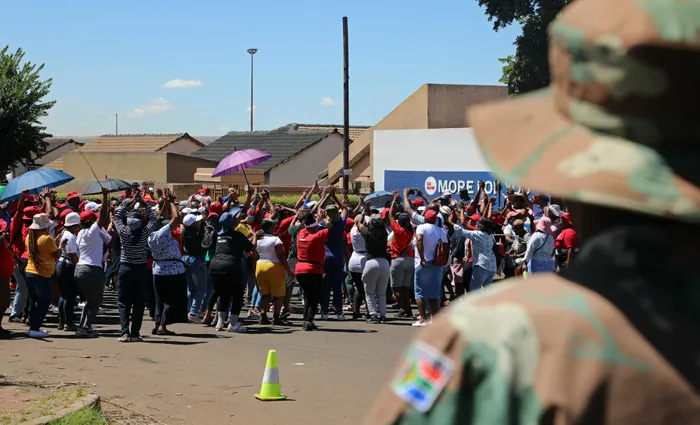Brinkmanship, divide and rule tactics weakens worker unity

Picture: Timothy Bernard/African News Agency (ANA) – SANDF and police were deployed to protect non-striking workers at the Thelle Mogoerane hospital, in Vosloorus, during a strike by Nehawu members earlier this month. The government successfully forced the public sector union to back down on its wage demands, the writer says.
By Trevor Ngwane
All is well that ends well. Now that the public sector strike is over, we can all go back to our daily lives, unbothered by ungrateful workers causing chaos in hospitals, disturbing the peace, and disrupting the smooth operation of our public service.
Communiques seem to suggest that this is what the government wants us to believe about how the recent public sector strike, led by the National Education, Health and Allied Workers Union (Nehawu), was conducted and resolved.
But there’s more to this than meets the eye, and some of it might give considerable cause for concern. It will be worrisome to many observers sympathetic to the working-class cause that the workers returned to work without winning one cent more than what the government had offered.
In 2022, the public sector unions were united in their opposition to the government’s unilateral imposition of a 3 percent wage increase when inflation stood at 7.9 percent. This was the last straw as the government reneged on implementing the third leg of a wage agreement it had negotiated and duly signed.
What game is the government playing? What is its plan for public sector workers and the public services they help provide? What are the implications for society?
Brinkmanship is a reckless political method that dominated the Cold War era. The idea is to push your opponent to the brink of war and mutual catastrophe, thus forcing the hapless adversary to relent and submit to your will and power. In contemporary military strategy, dangerous tactics involve the threat of nuclear war.
While this tactic occurs in international politics and foreign policy, the ANC government seems to be adapting it for use in labour relations. Using extreme daredevil methods, it successfully forced public sector unions to back down on their wage demands. In 2020, seeking to make the rating agencies happy, former finance minister Tito Mboweni proposed that the public sector wage bill should be reduced through freezing wage increases for three years as part of fiscal discipline and managing the country’s debt-to-GDP ratio.
Thus, in the middle of the Covid-19 pandemic when healthcare workers were champions in the front line of the war against disease to save lives while risking theirs, the ANC government reneged on the last leg of the 2018/19 to 2020/21 public sector wage deal. In 2021/22, the government gave workers a non-pensionable R1,000 cash gratuity and no increase in the salary baseline; in effect, this was a 4.5 percent wage cut.
The attacks on workers’ purchasing power were the culmination of almost a decade of austerity directed at the public sector which saw the ratio of health-care workers to users fall to 669 per 100,000 users, down from 722 in 2012. In 2022, there were 164,661 vacant posts in the public sector, with 26,444 vacancies in the public hospitals.
In other words, the cuts were felt solely by public sector workers and those who use public services. It is in the context of this barrage of attacks and provocations that Nehawu workers went on strike, demanding a living wage and better working conditions.
But why did Nehawu go out alone, and how was it defeated? What happened to the unity of the country’s three labour federations that we saw in the public sector National Day of Action on November 22, 2022, following the collapse of wage negotiations? Where was the solidarity from those who use public services?
The confrontation between the ANC government and the public sector unions has long been coming since the great public sector strike of 2010. Except that this time, driven by its neoliberal economic policy towards austerity, and sensing the vulnerability of the unions in the context of difficult economic conditions, rising unemployment, tightening of strike laws and relatively low union densities, the “employer” was ready to move in for the kill.
The arsenal at the disposal of the state against the strike consisted of court interdicts, bureaucratic strike procedures, pleading budget constraints, invoking the notion of “essential services”, threatening to fire workers, scapegoating them for public service failures, arresting and intimidating strikers, and more. The most diabolical feat was playing divide and rule among unions, exploiting differences and using inducements to sow division that culminated in half the unions entering new negotiations for the 2023/24 cycle while Nehawu was on strike and other unions boycotted the proceedings.
The boycotters were forced to relent, albeit reluctantly. The government is negotiating with a divided and bitter adversary. Public sector strikes have never been easy for workers because the disruption of services affects the public who resent this. Often, this is used to undermine public sector workers’ right to strike. During the Nehawu strike, the minister of health repeatedly and spuriously blamed the strikers for patient deaths and the media focused attention on the “violence” and chaos of the strike.
But the defeat of the strike might not end well for the ANC because it won by attacking the people whose votes it will need in 2024. The workers might yet exact their revenge.
Trevor Ngwane is Director of the Centre for Sociological Research and Practice, University of Johannesburg